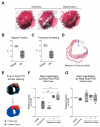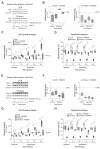Neu3 Sialidase Activates the RISK Cardioprotective Signaling Pathway during Ischemia and Reperfusion Injury (IRI)
- PMID: 35682772
- PMCID: PMC9181429
- DOI: 10.3390/ijms23116090
Neu3 Sialidase Activates the RISK Cardioprotective Signaling Pathway during Ischemia and Reperfusion Injury (IRI)
Abstract
Coronary reperfusion strategies are life-saving approaches to restore blood flow to cardiac tissue after acute myocardial infarction (AMI). However, the sudden restoration of normal blood flow leads to ischemia and reperfusion injury (IRI), which results in cardiomyoblast death, irreversible tissue degeneration, and heart failure. The molecular mechanism of IRI is not fully understood, and there are no effective cardioprotective strategies to prevent it. In this study, we show that activation of sialidase-3, a glycohydrolytic enzyme that cleaves sialic acid residues from glycoconjugates, is cardioprotective by triggering RISK pro-survival signaling pathways. We found that overexpression of Neu3 significantly increased cardiomyoblast resistance to IRI through activation of HIF-1α and Akt/Erk signaling pathways. This raises the possibility of using Sialidase-3 activation as a cardioprotective reperfusion strategy after myocardial infarction.
Keywords: Neu3; cardioprotective strategies; gangliosides; ischemia and reperfusion injury; myocardial infarction; sialidase-3.
Conflict of interest statement
The authors declare that the research was conducted in the absence of any commercial or financial relationships that could be construed as a potential conflict of interest.
Figures








Similar articles
-
Cardioprotective Strategies After Ischemia-Reperfusion Injury.Am J Cardiovasc Drugs. 2024 Jan;24(1):5-18. doi: 10.1007/s40256-023-00614-4. Epub 2023 Oct 10. Am J Cardiovasc Drugs. 2024. PMID: 37815758 Free PMC article. Review.
-
Cardiac-Specific SOCS3 Deletion Prevents In Vivo Myocardial Ischemia Reperfusion Injury through Sustained Activation of Cardioprotective Signaling Molecules.PLoS One. 2015 May 26;10(5):e0127942. doi: 10.1371/journal.pone.0127942. eCollection 2015. PLoS One. 2015. PMID: 26010537 Free PMC article.
-
The cardioprotective effect of dihydromyricetin prevents ischemia-reperfusion-induced apoptosis in vivo and in vitro via the PI3K/Akt and HIF-1α signaling pathways.Apoptosis. 2016 Dec;21(12):1366-1385. doi: 10.1007/s10495-016-1306-6. Apoptosis. 2016. PMID: 27738772
-
Ischemia/Reperfusion Injury following Acute Myocardial Infarction: A Critical Issue for Clinicians and Forensic Pathologists.Mediators Inflamm. 2017;2017:7018393. doi: 10.1155/2017/7018393. Epub 2017 Feb 13. Mediators Inflamm. 2017. PMID: 28286377 Free PMC article. Review.
-
Platelet Contributions to Myocardial Ischemia/Reperfusion Injury.Front Immunol. 2019 Jun 6;10:1260. doi: 10.3389/fimmu.2019.01260. eCollection 2019. Front Immunol. 2019. PMID: 31244834 Free PMC article. Review.
Cited by
-
Analysis of the intramolecular 1,7-lactone of N-acetylneuraminic acid using HPLC-MS: relationship between detection and stability.Glycoconj J. 2023 Jun;40(3):343-354. doi: 10.1007/s10719-023-10114-x. Epub 2023 Apr 21. Glycoconj J. 2023. PMID: 37084126 Free PMC article.
References
-
- Virani S.S., Alonso A., Benjamin E.J., Bittencourt M.S., Callaway C.W., Carson A.P., Chamberlain A.M., Chang A.R., Cheng S., Delling F.N., et al. Heart Disease and Stroke Statistics-2020 Update: A Report From the American Heart Association. Circulation. 2020;141:e139–e596. doi: 10.1161/CIR.0000000000000757. - DOI - PubMed
-
- Benjamin E.J., Blaha M.J., Chiuve S.E., Cushman M., Das S.R., Deo R., de Ferranti S.D., Floyd J., Fornage M., Gillespie C., et al. Heart Disease and Stroke Statistics-2017 Update: A Report From the American Heart Association. Circulation. 2017;135:e146–e603. doi: 10.1161/CIR.0000000000000485. - DOI - PMC - PubMed
-
- Roule V., Ardouin P., Blanchart K., Lemaitre A., Wain-Hobson J., Legallois D., Alexandre J., Sabatier R., Milliez P., Beygui F. Prehospital fibrinolysis versus primary percutaneous coronary intervention in ST-elevation myocardial infarction: A systematic review and meta-analysis of randomized controlled trials. Crit. Care. 2016;20:359. doi: 10.1186/s13054-016-1530-z. - DOI - PMC - PubMed
MeSH terms
Substances
Grants and funding
LinkOut - more resources
Full Text Sources
Medical
Miscellaneous

